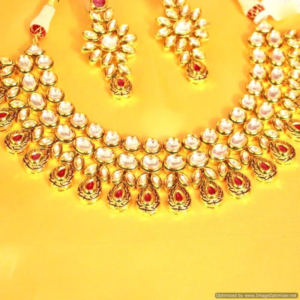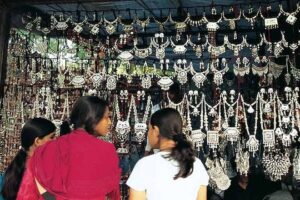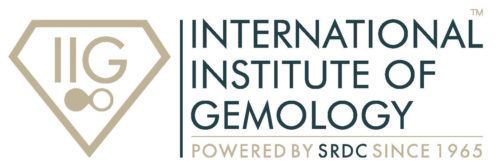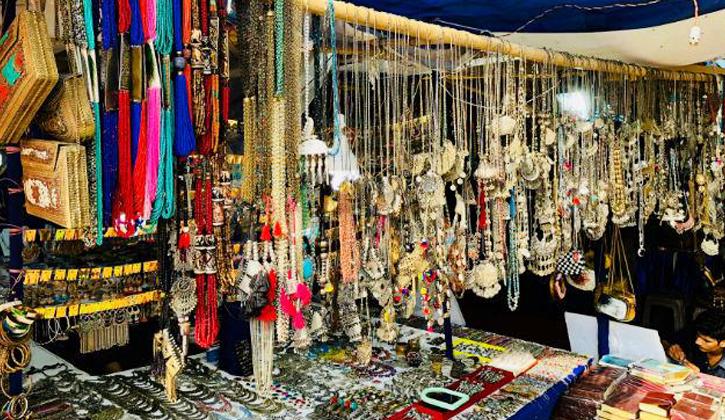|
Getting your Trinity Audio player ready...
|
“Unity in diversity” is a phrase often used to describe India’s rich cultural tapestry, where people from various backgrounds, languages, religions, and traditions come together as a single nation. This unity is beautifully reflected in Indian jewellery, which encompasses a wide range of styles, materials, and techniques, each representing the unique heritage of different regions while contributing to the larger identity of Indian jewellery as a whole.
Here’s how “Unity in Diversity” is expressed through Indian Jewellery Markets:-
India’s jewellery markets are a true reflection of the country’s unity in diversity, showcasing a rich tapestry of cultures, traditions, and craftsmanship. From north to south, east to west, India boasts a myriad of jewellery markets that cater to diverse tastes and preferences, while celebrating the country’s multicultural heritage.
Jaipur, Rajasthan Market
Known as the “Pink City,” Jaipur is renowned for its vibrant gemstone jewelry, particularly intricate designs featuring precious and semi-precious stones. The city’s historical connection to gem-cutting and trading has made it a hub for stunning pieces like Kundan, Meenakari, and Polki jewellery.

Mumbai, Maharashtra Market
As India’s financial and entertainment capital, Mumbai offers a blend of traditional and contemporary jewellery markets. The Zaveri Bazaar is famous for its gold and diamond jewellery, while the city’s high-end boutiques showcase modern and artistic designs.
Kolkata, West Bengal Market
Kolkata is celebrated for its intricate gold and silver filigree work. The city’s jewellery markets feature beautifully crafted designs inspired by Bengali culture and traditions.
Delhi Market
The bustling markets of Delhi, such as Chandni Chowk, offer an array of jewelry options, ranging from traditional to modern. Kundan, Polki, and jadau jewelry are popular choices, reflecting the city’s historical significance.

Hyderabad, Telangana Market
Renowned for its exquisite pearls and gemstone jewellery, Hyderabad’s markets are a treasure trove of Nizam-inspired designs, including the iconic Hyderabad Jadau and pearls.
Varanasi, Uttar Pradesh Market
This ancient city is famous for its intricate gold and silver jewellery, often embellished with enamel work and designs inspired by Hindu religious motifs.
Amritsar, Punjab Market
Known for its traditional Punjabi jewelry, Amritsar’s markets offer an assortment of striking gold ornaments, including the popular “jhumka” earrings and “kadas” (bangles).
Chennai, Tamil Nadu Market
South India’s jewelry markets showcase temple-inspired designs and intricate gold jewelry. The “temple jewellery” style, featuring elaborate motifs and designs, is a highlight.
Ahmedabad, Gujarat Market
The city is known for its unique styles like “Polki” and “Navratna” jewelry, which incorporate uncut diamonds and nine different gemstones, respectively.
Thiruvananthapuram, Kerala Market
The markets in this state are famed for their stunning gold ornaments, often characterized by intricate designs and fine craftsmanship.
Indian jewellery is not limited to one gender or age group. It is worn by men and women, young and old, across various occasions and celebrations, emphasizing the inclusivity and universality of its appeal.
India’s historical trade routes and interactions with various cultures have led to cross-cultural influences in its jewelry designs. The use of motifs, techniques, and materials from different parts of the world further reinforces the concept of unity in diversity.
Jewellery-making is a significant source of livelihood for many communities in India. This industry provides opportunities for artisans, craftsmen, and entrepreneurs from diverse backgrounds to showcase their skills and contribute to the country’s economy.
The unity in diversity is evident in the variety of materials, designs, and styles across these Jewellery markets. Whether it’s the regal elegance of Rajasthan, the opulent pearls of Hyderabad, or the intricate filigree work of Kolkata, each market tells a unique story of India’s cultural heritage and artistic prowess.
In summary, Indian jewelry beautifully exemplifies the concept of “unity in diversity.” It weaves together a myriad of cultural, historical, and artistic threads, creating a dazzling tapestry that celebrates India’s rich heritage while embracing its ever-evolving present.

